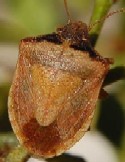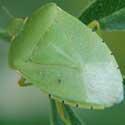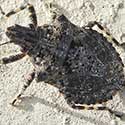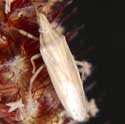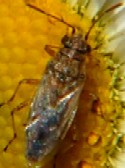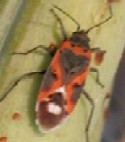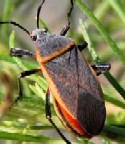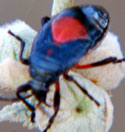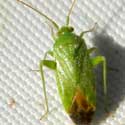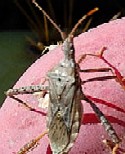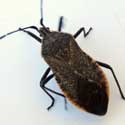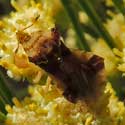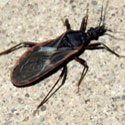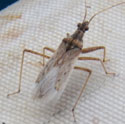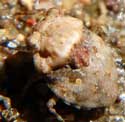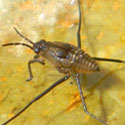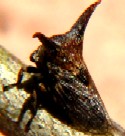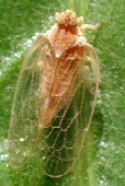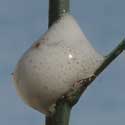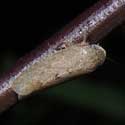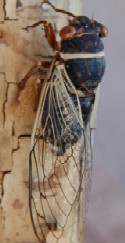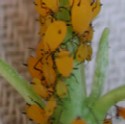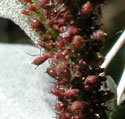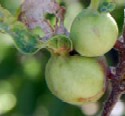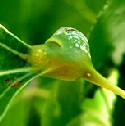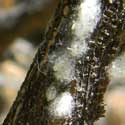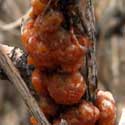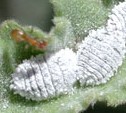Say's Stinkbug
Chlorochroa sayi
Emerald green with snowy spots. Outline in orange and an orange spot at tip of scutellum (triangular plate behind thorax). More info
Conchuela Bug
Chlorochroa ligata
Dark brown to nearly black. Outline in orange. Feeds on developing buds and seeds. More info
Creosote Stink Bug
Dendrocoris contaminatus
Rusty brown in shades similar to the host plant, Cresosote Bush (Larrea tridentata). Smaller than other stink bugs. More info
Spined Stink Bug
Loxa flavicollis
Large green stink bug (roughly pentagonal in shape) with lateral spines behind head. More info
Brown Stink Bug
Holcostethus sp.
Medium-sized bug with a grainy texture to the color. Occurs especially on trees and shrubs with developing seeds. More info
Green Stink Bug
Acrosternum hilare
All-green, pentagonal bug found on wide variety of trees and plants, usu. those with developing fruit or seeds. More info
Red-shouldered Stink Bug
Thyanta
Red on the margins of the pronotum can be faint or else expanded all across the anterior margin into reddish bar. Base color green or brown. More info
Harlequin Bug
Murgantia histrionica
Pentagonal shape intricately marked with bright yellow and/or orange on black. On mustard and capper plants. More info
Painted Stink Bug
Bagrata hilaris
A non-native bug recently transplanted from Afica or Europe to Southern California. It could spread eastward into the Arizona Sonoran Desert. More info
Rough Stink Bug
Brochymena parva
These bugs often hide on dark scaly bark of the trees or shrubs that feed them. There are several Brochymena species. More info
Narrow Stink Bug
Mecidea sp.
Pale brown or tan stink bug that is more slender than pentagonal. May be encountered on grass species. More info
Negro Bug
Corimelaena sp.
Small black bugs marked with some orange appearing like beetles due to enlarged scutellum. Common on desert tobacco. More info
Seed Bug
Nysius sp.
Small brown or gray bugs abundant on grasses and weeds with seeds. A number of similar species. More info
Milkweed Bug
Lygeaus kalmii
Sometimes gregarious red, black and white bugs on milkweeds and other plants in seed. Often in tandem. More info
Charcoal Seedbug Bug
Neacoryphus lateralis
Sometimes really abundant red & black bugs of late spring to fall. On seeding plants. More info
Redcoat Seed Bug
Melanopleurus sp.
Dressed like a British Soldier and not at all obscure as it inhabits composite inflorescences. More info
Dirt Colored Seed Bug
Pseudopamera sp?
Rather small and often hidden under rocks or leaf litter. Enlarged femur on first pair of legs. More info
Bordered Plant Bug
Largus sp.
Large bug mostly dark marked with bright orange around border and on underside of abdoment. Common on plants with maturing seeds. A couple of similar species. See nymph lower on this page. More info
Bordered Plant Bug (nymph)
Largus sp.
Metalic blue with orange triangle. Immature stage, and thus wingless, of Largus shown above. More info
Orange Fiddleneck Plant Bug
Plagiognathus moerens
Small, brightly colored, active bug in flower clusters of orange fiddleneck. Many similar bugs found on wide variety of plants. More info
Creosote Bush Plant Bug
Orthotylinae
Small, green and golden brown, active bug on new growth of Creosote Bush. Many similar bugs found on other Sonoran Desert plants. More info
Globe Mallow Bug
Keltonia
Pale green, very small, about 2mm, and quick-moving. Texture is like that of the mallow leaves. More info
Red Plant Bug
Lopidea
Delicate red and black plant bug found on developing seeds and flower buds of various plants. Several similar species. More info
Wolfberry Plant Bug
Miridae sp.
Small, about 3mm, mottled green and black designed to hide on buds/stems. This one found on Lycium. More info
Clouded Plant Bug
Neurocolpus
Small bug with speckled markings and enlarged antennae segments. An inhabitant of mesquite trees. More info
Ant Mimic Bug
Coquillettia
Even an Entomologist will look twice before realizing that this is not an ant! More info
Mesquite Coreid
Mozena sp.
Large tan or dark brown bug with sharp, flared points behind head and enlarged hind legs. Young are greenish. More info
Leaf-footed Bug
Leptoglossus zonatus
Large bugs with conspicuous flags on legs and white zigzag on back. Feeds on developing fruits. More info
Prickly Pear Leaf-footed Bug
Narnia sp.
Gray-brown bugs often in pairs on prickly pears. Medium-large size. More info
Leaf-footed Bug
Acanthocephala granulosus
Very large, conspicuous bugs most often on mesquite pods. Bright orange tips to legs and antennae set off by all black body. More info
Cactus Bug
Chelinidea vittiger
Gray-brown bugs on prickly pears with light-colored, geometric lines across wings. Leave brown circles on cactus pads. More info
Squash Bug
Anasa tristis
Brownish bugs with gray speckles. Found on vines of squash, melons etc. No "leaf" on hind legs. More info
Leaf-footed Bug
Catorhintha sp.
This one lacks the leaf-like expansion on the last pair of legs. More info
Leafhopper Assassin Bug
Zelus renardii
Spindly-legged predators often on flowers and new growth foliage. Prey sticks to glue on legs. More info
Four-spurred Assassin Bug
Zelus tetracanthus
Four spurs on the thorax and usually a gray color. Hunts for prey on new plant growth. More info
Orange Assassin
Pselliopsis sp.
Boldly colored predator of caterpillars and other bugs. Legs sharply banded with black rings. More info
Bee Assassin
Apiomeris flaviventris
Warning colored in black, red and yellow. Beak pierces bees and other insect prey. More info
Ambush Bug
Phymata sp.
Powerful, predatory bug looks like part of the flower and grabs bees and butterflies when they visit. More info
Kissing Bug
Triatoma rubida
Emerge from rock crevices at night to take blood from rodents and humans. Mostly black, narrow head with beak and large eyes. More info
Damsel Bug
Nabis sp.
Slender, gray-brown bugs with a noticeably elongated head and snout. About a cm long. Predators on plant feeding insects. More info
Minute Pirate Bug
Orius
Very small predators of even smaller insects! Commonly inside blooming flowers with thrips. More info
Toad Bug
Gelastocoris oculatus
Hops along on damp sand adjacent to riparian streams blending in perfectly. Predaceous. More info
Lace Bug
Corythucha sp.
Very small bugs feeding esp. on leaf undersides. Wings and prothorax of stiff, lacy chitin. More info
Stilt Bug
Jalysus sp.
Small, delicate plant feeding bugs with very long, slender legs and a distinct knob at tip of antennae. Pale brown to nearly transparent. More info
Tobacco Stilt Bug
Pronotacantha
Very slender, delicate plant feeding bugs with very long, slender legs and a distinct knob at tip of antennae. This one has a dark, prickly thorax. More info
Scentless Plant Bug
Arhyssus ?
Small, non-descript bug. Knobs at ends of antennae. Does not release scent when disturbed unlike many other similar bugs. More info
Bed Bug
Cimex lectularius
Red to brown bugs in dwellings. When starved very flat and can hide in narrow cracks. No wings. Feeds nocturnally on human blood. More info
Water Strider
Aquarius sp.
Glides on surface film of calm waters and preys on insects trapped there. Long spidery legs. More info
Small Water Strider
Rhagovelia
Similar to water striders, but smaller. Common on surfaces with floating algae. More info


